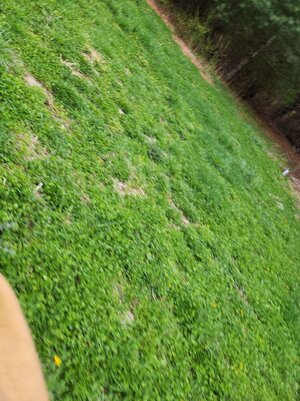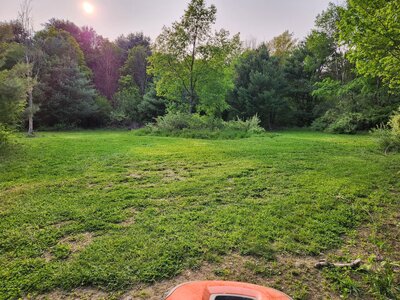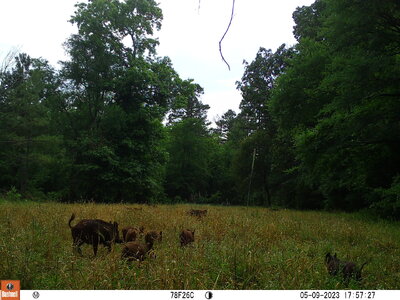-
The forum has been upgraded to support both light and dark themes. Click here for directions.
You are using an out of date browser. It may not display this or other websites correctly.
You should upgrade or use an alternative browser.
You should upgrade or use an alternative browser.
Frost seeding
- Thread starter 9x56MS
- Start date
yoderjac
Well-Known Member
In order to actually frost seed, you should wait until your daytime temperatures are warm enough to melt the top inch of soil but the nighttime temps are cold enough for it to refreeze. This causes cracking and heaving in the soil and the tiny clover seeds are sucked into the germination layer. I would avoid frost seeding with snow on the ground. This makes the seeds easy predation targets for birds. Frost seeding does not work for large seeds like oats.
Having said that, many cereal grains can be surface broadcast and germinate pretty well. With my soil, winter rye has better cereal germination rates than oats or winter wheat.
The reason folks frost seed perennial clover is usually to cover bare patches in an existing clover plot. Perennial clover is better established by planting it in the fall with a winter rye nurse crop. The rye can be mowed the following spring each time it gets a foot to 18" tall to release the clover slowly. This gives the perennial clover an advantage over annual summer weeds as much of it has germinated in the fall.
Frost seeding gives clover less of a jump on spring weeds, but it is better than waiting and planting it in the spring.
If you want to add oats, I'd frost seed the clover and then wait for early spring. I'd then surface broadcast the clover and cultipack it. The oats will need seed/soil contact and cultipacking helps.
Having said that, many cereal grains can be surface broadcast and germinate pretty well. With my soil, winter rye has better cereal germination rates than oats or winter wheat.
The reason folks frost seed perennial clover is usually to cover bare patches in an existing clover plot. Perennial clover is better established by planting it in the fall with a winter rye nurse crop. The rye can be mowed the following spring each time it gets a foot to 18" tall to release the clover slowly. This gives the perennial clover an advantage over annual summer weeds as much of it has germinated in the fall.
Frost seeding gives clover less of a jump on spring weeds, but it is better than waiting and planting it in the spring.
If you want to add oats, I'd frost seed the clover and then wait for early spring. I'd then surface broadcast the clover and cultipack it. The oats will need seed/soil contact and cultipacking helps.
Frost seeding oats, you risk them germinating and them getting killed by a late frost. I'd wait until the local frost window has closed before planting oats or something similar.
Is this a new plot? Has it been prepped? I wouldn't expect good results just frost seeding oats into ground that hasn't been planted previously.
Is this a new plot? Has it been prepped? I wouldn't expect good results just frost seeding oats into ground that hasn't been planted previously.
HuronMtn
Member
I haven't fully trusted Winter-Spring frost seeding and have avoided it after a couple of tries that didn't work out.I have been researching frost seeding clover food plots. I am going to try it for the first time this year. Does anyone here have any experience or tips to offer? Will oats germinate if just frost seeded? Thank you.
Several years ago I discovered Fall frost/dormant seeding.
At that time, I was being paid by the State to put in several fields for pollinators. The State guidelines and my conservationist explained I needed to get the pollinator seed mix planted the last two weeks before the ground froze for winter, mimicking Nature's normal process for frost seeding.
Since successfully doing this a number of times for pollinator plantings, I have tried this method for my food plot mixes and can attest it works extremely well. I should mention this is being done on well-drained sandy soils in Michigan's Upper Penisula where there is considerable winter snow cover and my last reliable tilling and seeding date is usually between October 20 - November 1. The mixes I plant consist of oats (either Forage Plus or Goliath late oats) as a spring nurse crop for my perennial mix: Aberlasting Clover, Small Burnett, Bruce Trefoil, and Oasis Chicory.
A disavantage of this method is that I am out working and disturbing my property during prime bow season. I have twelve food plots, so I typically limit myself to just do no more than two dorminant seedings per year. Since I have many plots the disturbance doesn't seem to be an issue for me, but it might be for someone that doesn't have as many options.
Last edited:
HuronMtn
Member
Good weather and good luck!Left out the oats and added chicory. Seeded last night as it is forecasting rain today. Now the waiting begins. Fingers crossed.
Mennoniteman
Well-Known Member
Great going on the frost seeding. Can you post a picture, I'd like to see it. I believe that 80 degree weather last week has advanced our spring by 2 weeks in 2 days here in PA.Wow this July weather in April has just blossemed that clover has shot up 6” high. Came out better than I expected.
9x56MS
Active Member
Sorry I haven’t gotten back to you. The pictures may be awhile as I just had both knees replaced.Great going on the frost seeding. Can you post a picture, I'd like to see it. I believe that 80 degree weather last week has advanced our spring by 2 weeks in 2 days here in PA.
MarkDarvin
Well-Known Member
I don't subscribe to the current thinking on frost seeding anymore. I don't think freezing and thawing has anything to do with germination. I think it's all temperature driven. The more I've read up on natural seeds, they've all got mechanisms to resist germinating at the wrong time. Jack pine and dogwood seeds are good examples of seeds that resist germination. A dogwood seed almost has to pass through the gut of an animal to break down the seed coat. Jack pine cones require fire to get opened so they can grow. I'm a big fan of pushing the envelope on early seeding.
Trust nature. Trust the science.
Trust nature. Trust the science.
Mennoniteman
Well-Known Member
I agree that germination is controlled by temperature. I thought frost seeding is to get good seed to soil contact for small seeds so that there's good germination when the temps are right? What yoderjac said in the second post pretty much sums up my thinking on frost seeding. Although unlike what he said, I have had success frost seeding oats, maybe it was just a freak occurence but I had close to 100% germination seeding oats on bare dirt.I don't subscribe to the current thinking on frost seeding anymore. I don't think freezing and thawing has anything to do with germination. I think it's all temperature driven. The more I've read up on natural seeds, they've all got mechanisms to resist germinating at the wrong time. Jack pine and dogwood seeds are good examples of seeds that resist germination. A dogwood seed almost has to pass through the gut of an animal to break down the seed coat. Jack pine cones require fire to get opened so they can grow. I'm a big fan of pushing the envelope on early seeding.
Trust nature. Trust the science.
MarkDarvin
Well-Known Member
I'll get better pics this coming weekend to show the current state of affairs once this snow has melted. This weekend will be a lot of getting down on the knees to inspect my seeding from this past weekend. I expect to see lots of cereals sprouted and reaching down.
yoderjac
Well-Known Member
I agree that germination is controlled by temperature. I thought frost seeding is to get good seed to soil contact for small seeds so that there's good germination when the temps are right? What yoderjac said in the second post pretty much sums up my thinking on frost seeding. Although unlike what he said, I have had success frost seeding oats, maybe it was just a freak occurence but I had close to 100% germination seeding oats on bare dirt.
Not that it makes any practical difference, I doubt the heaving of soil with the freeze thaw cycle made much difference with the oats. Most cereal grains can be surface broadcast. How well they germinate depends on a number of factors including your soil type. You are spot on that seed/soil contact is key. A cultipacker pressing seed into the ground or a nice heavy rain pounding the seed and splashing soil on them can give good germination rates. My soil is heavy clay and the OM content is finally starting to come back. In my soil, WR provides me the best germination rates when surface broadcast. That does not mean I can't surface broadcast other cereal grains, I just need to increase the seeding rate to compensate.
My guess is that if you frost seeded clover and had just waited until freezing was over to broadcast the clover, you're germination rates would be similar. In general, frost seeding works best when overseeding an existing perennial clover field that is patchy. I don't get good results frost seeding larger seed annual clovers like Crimson. I never plant perennial clover in the spring. I find you spend too much time and energy fighting weeds. I think the best practice is to broadcast perennial clover with a nurse crop in the fall. Perennial clover spends quite a bit of time putting down a root system. When planted in the fall, it has time to germinate but depending on when you plant, it may not do much more in the fall. The cereal acts as the fall attractant. This gives the clover an early jump on weeds. If you use WR as the nurse crop, it not only takes up space, but also has an allopathic effect on weeds. Timely mowing that first spring releases the clover from the WR so it is taking over when the WR dies naturally in the summer before weeds can take hold.
I find that frost seeding perennial clover does not give it as much jump on weeds. You end up with more weeds and a shorter-lived clover field.
Don't get me wrong, I've very weed tolerant when it comes to clover. I like to start off with as weed free field as possible. After that first spring of mowing the WR, I just mow once a year just before our season. After a couple years, you would not even know it is a clover field in the summer because of the weeds unless you get on your hands and knees and look under the weeds. Yet after the fall mowing and when nights turn cool an our fall rains come, the clover bounces back and takes over the field. I no longer use herbicides to control weeds in clover for the most part.
Similar threads
- Replies
- 2
- Views
- 848
- Replies
- 15
- Views
- 808




